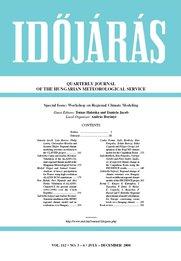Időjárás - Quarterly Journal of the Hungarian Meteorological Service (OMSZ)
Vol. 112, No. 3-4 * Pages 141–300 * July - December 2008
 |
Special Issue: Workshop on Regional Climate Modeling Guest Editors: Tomas Halenka and Daniela Jacob |
Regional climate modeling activities in relation to the CLAVIER project
Xob, D., Kotova, L.., Lorenz, Ph., Moseley, Ch., Pfeifer, S.
idojaras.2008.3-4.1 (p. 141–)
Xob, D., Kotova, L.., Lorenz, Ph., Moseley, Ch., Pfeifer, S.
idojaras.2008.3-4.1 (p. 141–)
Validation of the ALADIN-Climate regional climate model at the Hungarian Meteorological Service
Csima Gabriella, Horányi András
idojaras.2008.3-4.2 (p. 155–)
Csima Gabriella, Horányi András
idojaras.2008.3-4.2 (p. 155–)
Analysis of heavy precipitation for France using high resolution ALADIN RCM simulations
Déqué, M., Somot, S.
idojaras.2008.3-4.3 (p. 179–)
Déqué, M., Somot, S.
idojaras.2008.3-4.3 (p. 179–)
Transient simulation of the REMO regional climate model and its evaluation over Hungary
Szépszó Gabriella, Horányi András
idojaras.2008.3-4.4 (p. 179–)
Szépszó Gabriella, Horányi András
idojaras.2008.3-4.4 (p. 179–)
Validation of ALADIN-Climate/CZ for present climate (1961–1990) over the Czech Republic
Skalák, P., Stepánek, P., Farda, A.
idojaras.2008.3-4.5 (p. 191–)
Skalák, P., Stepánek, P., Farda, A.
idojaras.2008.3-4.5 (p. 191–)
Adaptation of the RegCM3 climate model for the Carpathian Basin
Torma Csaba, Bartholy Judit, Pongrácz Rita, Barcza Zoltán, Coppola, E., Giorgi, F.
idojaras.2008.3-4.6 (p. 233–)
Torma Csaba, Bartholy Judit, Pongrácz Rita, Barcza Zoltán, Coppola, E., Giorgi, F.
idojaras.2008.3-4.6 (p. 233–)
Analysis of expected climate change in the Carpathian Basin using the PRUDENCE results
Bartholy Judit, Pongrácz Rita, Gelybó Györgyi, Szabó Péter
idojaras.2008.3-4.7 (p. 249–)
Bartholy Judit, Pongrácz Rita, Gelybó Györgyi, Szabó Péter
idojaras.2008.3-4.7 (p. 249–)
Regional change of climate extremes over Hungary based on different regional climate models of the PRUDENCE project
Szépszó Gabriella
idojaras.2008.3-4.8 (p. 265–)
Szépszó Gabriella
idojaras.2008.3-4.8 (p. 265–)
Regional photochemical model calculations for Europe concerning ozone levels in a changing climate
Krüger, B.C., Katragkou, E., Tegoulias, I., Zanis, P., Melas, D., Coppola, E., Rauscher, S., Huszar, P., IIIenka, T.
idojaras.2008.3-4.9 (p. 285–)
Krüger, B.C., Katragkou, E., Tegoulias, I., Zanis, P., Melas, D., Coppola, E., Rauscher, S., Huszar, P., IIIenka, T.
idojaras.2008.3-4.9 (p. 285–)
IDŐJÁRÁS - Quarterly Journal

Az IDŐJÁRÁS a HungaroMet Nonprofit Zrt. negyedévenként megjelenő angol nyelvű folyóirata
Megrendelhető a journal.idojaras@met.hu címen.
A szerzőknek szánt útmutató itt olvasható.
Megrendelhető a journal.idojaras@met.hu címen.
A szerzőknek szánt útmutató itt olvasható.









